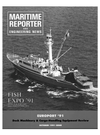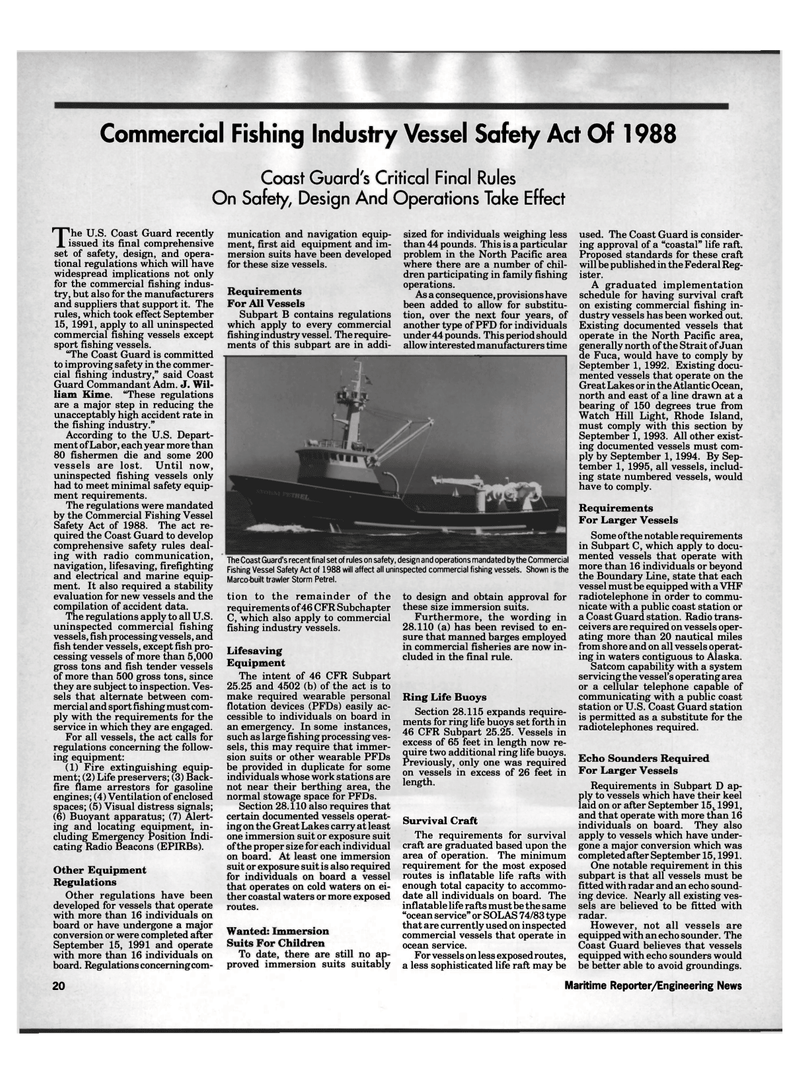
Page 18: of Maritime Reporter Magazine (October 1991)
Read this page in Pdf, Flash or Html5 edition of October 1991 Maritime Reporter Magazine
Commercial Fishing Industry Vessel Safety Act Of 1988
Coast Guard's Critical Final Rules
On Safety, Design And Operations Take Effect
T'he U.S. Coast Guard recently issued its final comprehensive set of safety, design, and opera- tional regulations which will have widespread implications not only for the commercial fishing indus- try, but also for the manufacturers and suppliers that support it. The rules, which took effect September 15, 1991, apply to all uninspected commercial fishing vessels except sport fishing vessels. "The Coast Guard is committed to improving safety in the commer- cial fishing industry," said Coast
Guard Commandant Adm. J. Wil- liam Kime. "These regulations are a major step in reducing the unacceptably high accident rate in the fishing industry."
According to the U.S. Depart- ment of Labor, each year more than 80 fishermen die and some 200 vessels are lost. Until now, uninspected fishing vessels only had to meet minimal safety equip- ment requirements.
The regulations were mandated by the Commercial Fishing Vessel
Safety Act of 1988. The act re- quired the Coast Guard to develop comprehensive safety rules deal- ing with radio communication, navigation, lifesaving, firefighting and electrical and marine equip- ment. It also required a stability evaluation for new vessels and the compilation of accident data.
The regulations apply to all U.S. uninspected commercial fishing vessels, fish processing vessels, and fish tender vessels, except fish pro- cessing vessels of more than 5,000 gross tons and fish tender vessels of more than 500 gross tons, since they are subject to inspection. Ves- sels that alternate between com- mercial and sport fishing must com- ply with the requirements for the service in which they are engaged.
For all vessels, the act calls for regulations concerning the follow- ing equipment: (1) Fire extinguishing equip- ment; (2) Life preservers; (3) Back- fire flame arrestors for gasoline engines; (4) Ventilation of enclosed spaces; (5) Visual distress signals; (6) Buoyant apparatus; (7) Alert- ing and locating equipment, in- cluding Emergency Position Indi- cating Radio Beacons (EPIRBs).
Other Equipment
Regulations
Other regulations have been developed for vessels that operate with more than 16 individuals on board or have undergone a major conversion or were completed after
September 15, 1991 and operate with more than 16 individuals on board. Regulations concerning com- munication and navigation equip- ment, first aid equipment and im- mersion suits have been developed for these size vessels.
Requirements
For All Vessels
Subpart B contains regulations which apply to every commercial fishing industry vessel. The require- ments of this subpart are in addi- sized for individuals weighing less than 44 pounds. This is a particular problem in the North Pacific area where there are a number of chil- dren participating in family fishing operations.
As a consequence, provisions have been added to allow for substitu- tion, over the next four years, of another type of PFD for individuals under 44 pounds. This period should allow interested manufacturers time
The Coast Guard's recent final set of rules on safety, design and operations mandated by the Commercial
Fishing Vessel Safety Act of 1988 will affect all uninspected commercial fishing vessels. Shown is the
Marco-built trawler Storm Petrel. tion to the remainder of the requirements of 46 CFR Subchapter
C, which also apply to commercial fishing industry vessels.
Lifesaving
Equipment
The intent of 46 CFR Subpart 25.25 and 4502 (b) of the act is to make required wearable personal flotation devices (PFDs) easily ac- cessible to individuals on board in an emergency. In some instances, such as large fishing processing ves- sels, this may require that immer- sion suits or other wearable PFDs be provided in duplicate for some individuals whose work stations are not near their berthing area, the normal stowage space for PFDs.
Section 28.110 also requires that certain documented vessels operat- ing on the Great Lakes carry at least one immersion suit or exposure suit of the proper size for each individual on board. At least one immersion suit or exposure suit is also required for individuals on board a vessel that operates on cold waters on ei- ther coastal waters or more exposed routes.
Wanted: Immersion
Suits For Children
To date, there are still no ap- proved immersion suits suitably to design and obtain approval for these size immersion suits.
Furthermore, the wording in 28.110 (a) has been revised to en- sure that manned barges employed in commercial fisheries are now in- cluded in the final rule.
Ring Life Buoys
Section 28.115 expands require- ments for ring life buoys set forth in 46 CFR Subpart 25.25. Vessels in excess of 65 feet in length now re- quire two additional ring life buoys.
Previously, only one was required on vessels in excess of 26 feet in length.
Survival Craft
The requirements for survival craft are graduated based upon the area of operation. The minimum requirement for the most exposed routes is inflatable life rafts with enough total capacity to accommo- date all individuals on board. The inflatable life rafts must be the same "ocean service" or SOLAS 74/83 type that are currently used on inspected commercial vessels that operate in ocean service.
For vessels on less exposed routes, a less sophisticated life raft may be used. The Coast Guard is consider- ing approval of a "coastal" life raft.
Proposed standards for these craft will be published in the Federal Reg- ister.
A graduated implementation schedule for having survival craft on existing commercial fishing in- dustry vessels has been worked out.
Existing documented vessels that operate in the North Pacific area, generally north of the Strait of Juan de Fuca, would have to comply by
September 1, 1992. Existing docu- mented vessels that operate on the
Great Lakes or in the Atlantic Ocean, north and east of a line drawn at a bearing of 150 degrees true from
Watch Hill Light, Rhode Island, must comply with this section by
September 1, 1993. All other exist- ing documented vessels must com- ply by September 1, 1994. By Sep- tember 1, 1995, all vessels, includ- ing state numbered vessels, would have to comply.
Requirements
For Larger Vessels
Some of the notable requirements in Subpart C, which apply to docu- mented vessels that operate with more than 16 individuals or beyond the Boundary Line, state that each vessel must be equipped with a VHF radiotelephone in order to commu- nicate with a public coast station or a Coast Guard station. Radio trans- ceivers are required on vessels oper- ating more than 20 nautical miles from shore and on all vessels operat- ing in waters contiguous to Alaska.
Satcom capability with a system servicing the vessel's operating area or a cellular telephone capable of communicating with a public coast station or U.S. Coast Guard station is permitted as a substitute for the radiotelephones required.
Echo Sounders Required
For Larger Vessels
Requirements in Subpart D ap- ply to vessels which have their keel laid on or after September 15,1991, and that operate with more than 16 individuals on board. They also apply to vessels which have under- gone a major conversion which was completed after September 15,1991.
One notable requirement in this subpart is that all vessels must be fitted with radar and an echo sound- ing device. Nearly all existing ves- sels are believed to be fitted with radar.
However, not all vessels are equipped with an echo sounder. The
Coast Guard believes that vessels equipped with echo sounders would be better able to avoid groundings. 20 Maritime Reporter/Engineering News

 17
17

 19
19
